Broccoli Diseases
Broccoli Diseases
Damping Off
Disease symptoms:
- Damping off occurs in two stages, i.e. the pre-emergence and the post-emergence phase.
- In the pre-emergence phase the seedlings are killed just before they reach the soil surface.
- The young radical and the plumule are killed and there is complete rotting of the seedlings.
- The post-emergence phase is characterized by the infection of the young, juvenile tissues of the collar at the ground level.
- The infected tissues become soft and water soaked. The seedlings topple over or collapse.
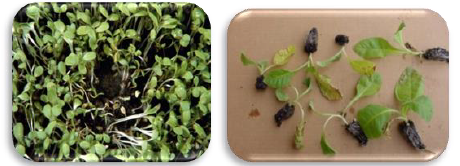
Favourable Conditions:
- High humidity, high soil moisture, cloudiness and low temperatures below 24° C for few days are ideal for infection and development of disease.
- Crowded seedlings, dampness due to high rainfall, poor drainage and excess of soil solutes hamper plant growth and increase the pathogenic damping-off.
Survival and spread:
- Primary: Soil, Seed, Water
- Secondary: Zoospore through rain splash or wind
Club root of crucifers or Finger and toe disease
Disease symptoms:
- Stunting and yellowing of plants
- Leaves become yellowish and wilt on hot days.
- Club like swelling of root and rootlets
- Club root is particularly prevalent on soils with a pH below 7, whereas it has been observed that the disease is often less serious on heavy soils and on soils containing little organic matter.
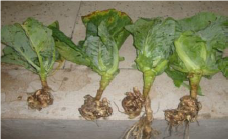
Survival and spread:
- Primary: Soil borne resting spores, which survive for longer periods in soil (10 yrs.) Collateral hosts: Broccoli, Brussels sprout, cabbage, cauliflower, Chinese cabbage, mustard, raddish, turnip
- Secondary: Resting spores or zoospores carried through irrigation water or by root contact.
Favourable conditions:
- It occur at a temperature range of 12-270C.
- High soil moisture
- Neutral to acidic soils 5-7.0 pH
Alternaria leaf spot
Common on cabbage, cauliflower and mustard.
Disease symptoms:
- Spots are small, dark coloured
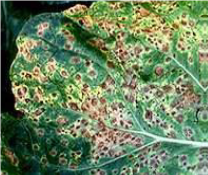
- They enlarge, soon become circular with a 1mm in diameter
- Under humid conditions groups of conidiophores will be formed in the spot
- Spots develop concentric rings
- Finally the spots coalesce leading to blighting of leaves.
- Shriveling of seeds and poor germination occurs.
- Linear spots also appear on petioles, stems, pods and seeds
Survival and spread:
- Primary: Mycelium persisting in the seed or as spores on seed or from debris
- Secondary: Wind or insect borne conidia
Favourable conditions:
- Soil temperature of around 280C
- High humidity or persistent dew
- Moist weather with intermittent showers
Black rot
Serious on cabbage, cauliflower, knol-khol and radish
Disease symptoms:
- First appear as chlorotic or yellow (angular) areas near the leaf margins
- Yellow area extends to veins and midrib forming characteristic ‘v’ shaped chlorotic spotswhich later turn black
- Veins and veinlets turn brown and finally black
- Vascular blackening extend beyond affected veins to midrib, petiole and stem
- In advanced stages, infection may reach the roots system and blackening of vascular bundles occurs. Bacterial ooze can also be seen on affected parts
- If the infection is early, the plants wilt and die
- If the infection is late plants succumb to soft rot and die.
Survival and spread:
- Primary : Bacterial cells internally seed borneand soil borne
- Secondary: Bacterial cells dispersed through irrigation water and rain splashes.
Favourable conditions:
- Relative humidity more than 90%
- High soil moisture
- Frequent rains
Downy mildew
Severe in radish, cabbage, cauliflower, mustard and knol-khol.
Disease symptoms:
- Small purplish brown spots on under surface of leaves
- Small, pale yellow angular spots on
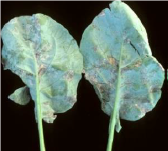 upper surface of leaves, with downy growth on the under surface. The spots coalesce and the leaves shrivel and dries up prematurely
upper surface of leaves, with downy growth on the under surface. The spots coalesce and the leaves shrivel and dries up prematurely - In cabbage, these spots expose the heads to soft rot
- Cauliflower curds look brownish
- Stems show dark brown and depressed lesions or streaks which later develop downy growth of fungus.
Survival and spread:
- Primary: Oospores in infected plant debris or in soil
- Secondary: Wind borne and rain splashed sporangia
Favourable conditions:
- It occur at a moderate temperature range of 12-270C
- High soil moisture
- Neutral to acidic soils, pH 5-7.
White rust
Disease symptoms:
- White, shiny raised blisters (pustules) on the lower surfaces of leaves, stems and flowers
- Pustules coalesce to form irregular patch
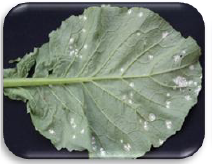 es
es - The epidermis ruptures exposing white spore mass which gives the pustule a powdery appearance
- Distortion of the floral parts including petals, pistils and anthers due to hypertrophy and hyperplasia
- Plants are malformed
Survival and spread:
- Primary: Oospores in soil and sporangia from perennial weed hosts in the vicinity
- Secondary: Wind borne and rain splashed conidia (sporangia) or autonomous zoospores
Favourable conditions:
- Relative humidity more than 90%
- High soil moisture
- Frequent rains
Disease cycles
Downy mildew
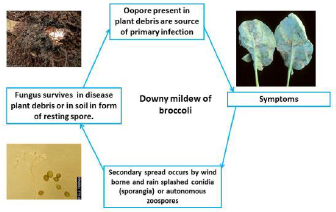
White rust
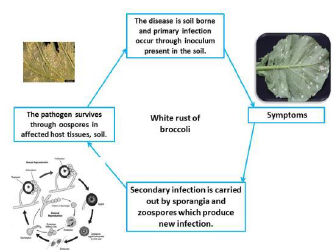
Alternaria leaf spot
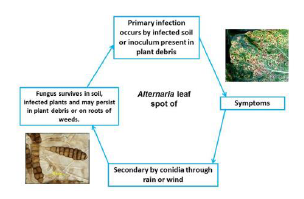
Damping off
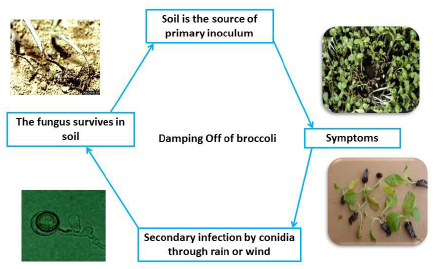
IPM for Braccoli
To know the IPM practices for Braccoli, click here.
Source: NIPHM, Directorate of Plant Protection, Quarantine & Storage
Last Modified : 3/22/2020
This topic covers information about Ber Diseases.
This topic covers information about Fig Diseases.
This topic covers information about Arecanut Dise...
This topic provides information about Apricot-Desc...
